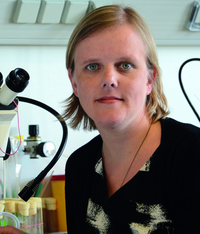Johannes Gutenberg University (JGU) Mainz
Peter Baumann Dorothee Dormann Susanne Foitzik Thomas Hankeln Mark Helm Meret Huber Edward Lemke Brian Luke Helen May-Simera Marion Silies Lukas Stelzl Roland Strauss Andreas Wachter Marie-Luise Winz Eva Wolf Uwe Wolfrum Shuqing Xu Hans ZischlerGene regulatory mechanisms underlying neuronal function

We are interested to understand the molecular and circuit mechanisms behind neural computations. We study this in the fly visual system, where the anatomy and connectivity of the ~100 cell types are known with exquisite details, and powerful genetic tools exist to measure and manipulate. The identity and contribution of many cell types to specific visual processing steps has been worked out. Any given cell type achieves a functional state based on the expression of specific sets of genes. We for example recently identified a single transcription factor that determines fundamentally different processing strategies in first order interneurons of the fly visual system, namely luminance vs. contrast sensitivity. We are now broadly interested to understand how gene regulatory mechanisms specify and maintain neuronal function. Neurons also maintain their functional properties longer than their subcellular components. This suggests cell intrinsic mechanisms that keep the cell in a transcriptional state that is critical for maintenance of the neuron’s properties. The key determinant of this transcriptional state is the control of gene expression via correlated action of transcription factors and chromatin proteins. Thus, understanding the molecular mechanism behind gene expression control reveals the relationship between the gene expression and functional state.
Positions held
- Since 2019: W3 Professor, Faculty of Biology, Johannes Gutenberg University (JGU), Mainz
- 2015 - 2018: Group Leader at the European Neuroscience Institute Göttingen (ENI-G)
- 2009 - 2014: Postdoctoral researcher with Dr. Thomas Clandinin, Stanford University
Education
- 2009: PhD with Dr. Christian Klämbt, University of Münster
- 2005: Diploma in Biology, University of Münster
Selected publications by Marion Silies
Ketkar MD, Sporar K, Gür B, Ramos-Traslosheros G, Seifert M, Silies M (2020) Luminance Information Is Required for the Accurate Estimation of Contrast in Rapidly Changing Visual Contexts. Current Biology, 30:657-669 Link
Molina-Obando S, Vargas-Fique JF, Henning M, Gür B, Schladt TM, Akhtar J, Berger TK, Silies M (2019) ON selectivity in Drosophila vision is a multisynaptic process involving both glutamatergic and GABAergic inhibition. eLife, pii:e49373 Link
Peng J, Santiago IJ, Ahn C, Gur B, Tsui CK, Su Z, Xu C, Karakhanyan A, Silies M, Pecot MY (2018). Drosophila Fezf coordinates laminar-specific connectivity through cell-intrinsic and cell-extrinsic mechanisms. eLife 7:e33962 Link
Fisher YE, Leong JCS, Sporar K, Ketkar MD, Gohl DM, Clandinin TR and Silies M (2015) A visual pathway with wide field properties is required for elementary motion detection. Current Biology, 22:3178 – 3189 Link
Fisher YE*, Silies M* and Clandinin TR (2015) Orientation Selectivity Sharpens Motion Detection in Drosophila. Neuron 88:390-402 (* indicates equal contribution) Link
Silies M*, Gohl DM*, Fisher YE, Freifeld L, Clark DA, Clandinin TR (2013) Modular use of peripheral input channels tunes motion-detecting circuitry. Neuron, 79:111-127 (* indicates equal contribution) Link
Burke C, Huetteroth W, Owald D, Perisse E, Krashes M, Das G, Gohl DM, Silies M, Certel S, Waddell S (2012) Layered reward signaling through octopamine and dopamine in Drosophila. Nature, 492:433-437 Link